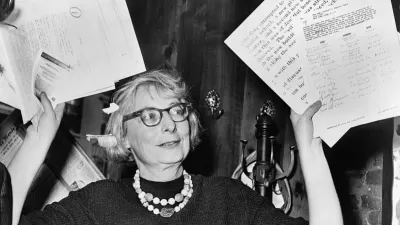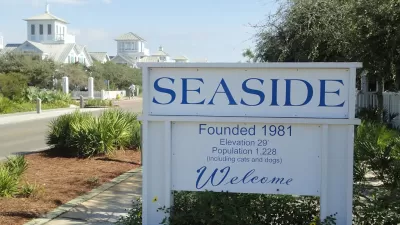A Market Urbanism op-ed makes the case for high-rise neighborhoods as an integral part of successful cities—even if some Jacobs fans tend to overlook the benefits of such parts of town.
Scott Beyer commemorates the birthday of Jane Jacobs by looking for a new middle ground between the two political ideologies that find support from Jacobs's writings.
First on the let-leaning side of Jane Jacobs's supporters, which "emphasize her work on urban form," according to Beyer. The right-leaning side, however,"[adores] the woman who loathed central planning and land use controls, and who thought that the 'organized complexity' of city life was best tackled through organic growth.
Despite the two ideologies that have risen from Jacobs's writings, Beyer argues that the left, represented by New Urbanists like Andres Duany, have gotten more attention.
"If you think today of what someone means when referring to a 'Jane Jacobs-style neighborhood,' you picture a medium-density area with historic character, pocket parks, and niche coffee shops—places like Greenwich Village, The Haight in San Francisco, Capitol Hill in Seattle, Wicker Park in Chicago, or Boston’s Back Bay. Meantime, large-scale neighborhoods—such as a typical downtown business district—are considered antithetical to Jacobian urbanism, and are frowned upon by planners."
Then Beyer takes the debate to a new place, to make a case for the value of high-rise neighborhoods, with a case study provided by the Brickell neighborhood in Miami.
FULL STORY: Happy Birthday Jane Jacobs! (Now Let’s Have A Debate)

Planetizen Federal Action Tracker
A weekly monitor of how Trump’s orders and actions are impacting planners and planning in America.

Chicago’s Ghost Rails
Just beneath the surface of the modern city lie the remnants of its expansive early 20th-century streetcar system.

San Antonio and Austin are Fusing Into one Massive Megaregion
The region spanning the two central Texas cities is growing fast, posing challenges for local infrastructure and water supplies.

Since Zion's Shuttles Went Electric “The Smog is Gone”
Visitors to Zion National Park can enjoy the canyon via the nation’s first fully electric park shuttle system.

Trump Distributing DOT Safety Funds at 1/10 Rate of Biden
Funds for Safe Streets and other transportation safety and equity programs are being held up by administrative reviews and conflicts with the Trump administration’s priorities.

German Cities Subsidize Taxis for Women Amid Wave of Violence
Free or low-cost taxi rides can help women navigate cities more safely, but critics say the programs don't address the root causes of violence against women.
Urban Design for Planners 1: Software Tools
This six-course series explores essential urban design concepts using open source software and equips planners with the tools they need to participate fully in the urban design process.
Planning for Universal Design
Learn the tools for implementing Universal Design in planning regulations.
planning NEXT
Appalachian Highlands Housing Partners
Mpact (founded as Rail~Volution)
City of Camden Redevelopment Agency
City of Astoria
City of Portland
City of Laramie





























